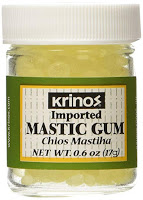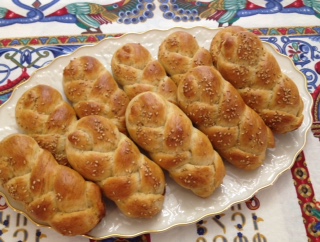

I’ve been eating choreg my entire life, which amounts to a LOT of choreg!
The recipe I know -and love- is savory – not sweet, and includes freshly ground mahlab, fennel seed, anise seed, and a touch of ground ginger- a very unique, but delicious blend.


In recent years, I’ve learned that some folks incorporate mastic into their choreg recipe – perhaps, one of those regional ingredients.
I was gifted a small sample of mastic with the understanding that I’d add it to my next choreg recipe – as an experiment.
(If you’ve ever eaten traditional locum, you have tasted mastic.)


Here are a few questions and answers to help you understand the Mastic Mystique:
What is mastic? It is an aromatic gum or resin exuded from the bark of a bushy evergreen Mediterranean tree that’s used in chewing gum and as a flavoring. It comes in powdered form and as small pellets which are somewhat sticky.
How is mastic used in a recipe? It is added to certain baked goods and/or candy recipes.
What does mastic taste like? To put it simply, it tastes earthy-piney with a hint of bitterness.
According to Wikipedia, “originally a sap, mastic is sun-dried into pieces of brittle, translucent resin. When chewed, the resin softens and becomes a bright white and opaque gum. The flavor is bitter at first, but after some chewing, it releases a refreshing flavor similar to pine and cedar.”
Since I had never used mastic before, I contacted friend, Aghavni Armoudian for her expert advice.
Here’s what she told me:
“I usually do not measure, so I would guess half a teaspoon. To pulvarize (mastic), I use my mortar and pestle, add the gum and an equal amount of sugar and the mahlab, and (then) smash/grind. The gum can get sticky, but the sugar and mahlab help. Then I pass it through a fine sieve to prevent larger pieces from going into the dough. Clean your utensils immediately!”
With my newly acquired knowledge, I was anxious to experiment with the mastic. Instead of making traditional choreg, I took the easier route and made koolunja using both mahlab and mastic.
I followed the koolunja recipe with a few changes. First, I used my husband’s bar tool, the muddler, to pulverize 1/2 teaspoon mastic along with 1 Tablespoon of sugar so it became powdery. (I didn’t pass it through the sieve as Aghavni suggested.) I added it to the flour then prepared and baked the recipe as stated.
Evaluation: Since I only made half the amount of koolunja, I should have only used 1/4 tsp. of mastic, half the amount suggested by Aghavni. The piney-bitter flavor seemed overwhelming, most-likely because I use very little sugar in my choreg – or koolunja. I’m convinced that mastic would be more appropriate in a sweet choreg recipe, but not necessarily in savory choreg such as mine.
Lesson learned!
Sts. Vartanantz Day is a moveable celebration on the Armenian Church calendar. This year it…
Just in time for soup season, Christine Datian offers The Armenian Kitchen her recipe for…
I don’t know about you, but in our family, we’re all about tradition when…
It’s that time of year again! St. Sarkis Day, the moveable feast day on the…
Way back in 2010 Ara Kassabian shared his family’s recipe for Nevik with The Armenian…
With Thanksgiving Day just hours away, I thought I’d share a few of our favorite,…
This website uses cookies. find out more.